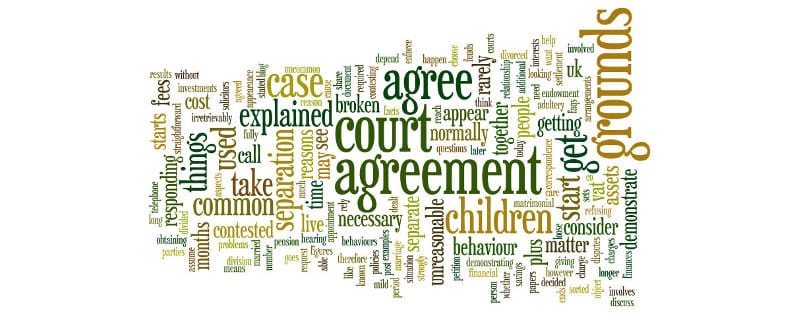Part of the challenge we face as family lawyers is demystifying the process and dealing with the jargon that besets the legal profession and court process. A recent discussion in the office resulted in a challenge to come up with a dictionary of family law terms, essentially an A-Z of words or phrases you might come across if you are going through divorce, separation or a case in the family courts. Although we started it as a bit of fun, we realised that although some of the terms are ones we’re very familiar with and come up almost every day in our work, they may not be commonly understood by others.
A is for adultery, in legal terms this is sex with someone of the opposite sex who is not your spouse. There’s a major misunderstanding around how adultery might impact on any divorce settlement (more).
B is for breach, something that can happen if one party to a formal court order fails to keep to the terms of that order. A breach of a child arrangements order is all too common, but is something you can take action on formally if the worst happens (more).
C is for common law marriage, which doesn’t exist in UK law. Regularly couples who have lived together for many years approach our lawyers for help unravelling their relationship and are often surprised to hear they don’t have the same legal protections as their married counterparts. (more).
D is for divorce, which is simply the legal ending of a marriage, allowing either party to remarry. Divorce doesn’t severe financial ties. (more).
E is for expats, who can often use the English courts to divorce. The main issues to be answered are in relation to where the parties are ‘domiciled’ and where they are habitually resident (normally live) (more).
F is for financial settlement, the agreement you will need to reach about money matters before you finalise your divorce. The formal process includes agreeing a Consent Order, a binding agreement severing the financial ties between a married couple (more about Consent Orders here).
G is for grandparents, sometimes caught up in the fall-out from a divorce or separation, with the potential they lose contact with their grandchildren. Grandparents are often distressed to learn they have no automatic rights when it comes to their grandchildren, but there are steps that can be taken (more).
H is for hearing, not all family law cases require a court hearing, many are dealt with through negotiation and written agreements. There are several different hearings depending on whether your case is a financial matter or concerns children. Your lawyer will explain to you what will happen at a hearing and make sure your case is adequately prepared (more).
I is for instructions, in essence what you ask your family lawyer to do on your behalf. They will be the legal expert and provide you with information and advice so that you can make informed decisions, you are required to give them clear instruction on how you would like them to proceed.
J is for judge, who will be required to make a decision on your case if it reaches court. In most family law cases this will be a District Judge sitting in a local court. Judges are required to review and approve court orders and will also be present at any court hearings.
K is for kids. The children can often be the real victims of any relationship breakdown. Parents need to work hard to put their children’s best interests at the centre of their decision making (more).
L is for leave to remove, an application one parent can make to take their child to live outside the country, away from the other parent. The court will consider practical issues like schooling, where the child will live, how the child will see the other parent and ultimately be concerned about what is in the best interest of the child (more).
M is for maintenance, one of the most hotly disputed issues in many divorces. Spousal maintenance may be appropriate where one party is unable to support themselves without financial help from their ex. Child maintenance is financial support that helps towards the everyday living costs of the children from a relationship. Child maintenance is not dealt with by the family courts and instead is administered by the Child Maintenance Service (CMS).
N is for nullity, or more commonly known as the annulment of a marriage. An annulment is a declaration by the court that a marriage was not legally valid or had become invalid. It will only be granted in a limited number of circumstances (more).
O is for order, any agreement made around finances for example will be written into a legally binding order which is then approved by the court. You might have another form of order put in place if you are unable to reach an agreement about the care of your children. This is known as a child arrangements order (more).
P is for parental responsibility, the rights, duties, powers, responsibilities and authority a parent has in relation to their child. Whilst mothers automatically have parental responsibilities things can be a little more complicated for fathers and same sex parents (more).
Q is for Questionnaire, exchanged after the completion of Form Es.
R is for Resolution, the membership body for family lawyers committed to the constructive resolution of family disputes. All Woolley & Co lawyers are members of Resolution.
S is for separation, sometimes formalised in a Deed of Separation or separation agreement. The purpose of the deed is for both parties to come to an agreement on how they would like their assets dealt with in any future divorce proceedings and could therefore avoid the cost and inconvenience of court proceedings at a later stage (more). Unmarried couples can also enter into a separation agreement.
T is for tenants, a term you will come across if you buy or rent a property. It can become very important whether you own a property as joint tenants or tenants in common if you are unmarried and split up. Likewise, if you rent with an unmarried partner the name or names on the tenancy agreement could become an important factor if you separate.
U is for undefended divorce, where both parties agree to the divorce taking place. Very few divorces are defended or contested, although the high profile case of Owens v Owens demonstrates how a defended divorce can make the headlines. With no fault divorce from April 2022 the option of defending a divorce is removed.
V is for variation, either party might apply to vary a financial order if financial or other circumstances change or a children order if it is no longer working or appropriate.
W is for Woolley & Co, it’s our job to get you through the A – Z of divorce with the least fuss, cost and upset (more)
And X, Y Z? If we’re honest we just couldn’t think of anything useful to explain with these initials – but we are open to suggestions via Twitter, Facebook, and Linked In!
Many more legal terms are explained in our Jargon Buster.
Woolley & Co
Divorce Solicitors


